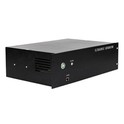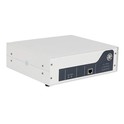Hey there! As a supplier of 1000w ultrasonic generators, I often get asked about the output current of these nifty devices. So, I thought I'd take a deep dive into this topic and share some insights with you.
First off, let's understand what an ultrasonic generator is. In simple terms, it's a device that converts electrical power into high - frequency electrical energy, which is then used to drive an ultrasonic transducer. The 1000w ultrasonic generator, as the name suggests, has a power rating of 1000 watts. But the output current isn't a fixed value and depends on several factors.
One of the key factors is the load impedance. You see, the ultrasonic generator is designed to work with a specific load, which is usually an ultrasonic transducer. The impedance of this transducer can vary depending on its design, size, and the application it's used for. According to Ohm's law (V = I×R, where V is voltage, I is current, and R is resistance or impedance in this case), if we know the power (P = V×I) and assume a constant voltage, the current will change as the impedance changes.
Let's say the ultrasonic generator operates at a certain voltage. For a 1000w device, if the load impedance is relatively low, the current will be higher to maintain the 1000 - watt power output. Conversely, if the load impedance is high, the current will be lower.
Another factor that affects the output current is the efficiency of the generator. No device is 100% efficient. There are always losses in the form of heat, electromagnetic radiation, and other factors. So, the actual power delivered to the load might be slightly less than the rated 1000w. And this can also have an impact on the output current.
In general, to calculate the output current, we can use the power formula P = V×I. Rearranging it gives us I = P/V. However, in real - world scenarios, it's not that straightforward because of the variable load impedance and efficiency issues.


For a 1000w ultrasonic generator, if we assume a typical operating voltage of around 220V (this can vary depending on the design and application), using the formula I = P/V, we get I = 1000/220 ≈ 4.55A. But again, this is a very rough estimate. In practice, the output current could range anywhere from a couple of amps to several amps depending on the factors we discussed earlier.
Now, you might be wondering why the output current matters. Well, it's crucial for several reasons. Firstly, it helps in determining the appropriate wiring and electrical components to be used in the system. If the current is too high, you need thicker wires and more robust electrical connections to prevent overheating and potential safety hazards. Secondly, it can give an indication of the performance of the ultrasonic generator and the load. Abnormal current values could suggest a problem with the transducer, the generator itself, or the overall system.
If you're in the market for an ultrasonic generator, you might also be interested in our other products. We also offer a 3000W Ultrasonic Generator and a 2000W Ultrasonic Generator. These generators are designed with high - quality components and advanced technology to ensure reliable performance.
Our 1000W Ultrasonic Generator is a great choice for a wide range of applications, including ultrasonic cleaning, welding, and emulsification. It's built to last and provides stable power output.
If you're considering purchasing an ultrasonic generator, whether it's the 1000w model or one of our other options, we're here to help. We can provide you with detailed technical specifications, answer any questions you might have, and guide you through the selection process. Feel free to reach out to us to start a procurement discussion. We're eager to work with you and meet your ultrasonic generator needs.
In conclusion, the output current of a 1000w ultrasonic generator is a complex topic that depends on multiple factors such as load impedance and efficiency. While we can make rough estimates using basic electrical formulas, real - world values can vary. But rest assured, as a supplier, we have the expertise to ensure that our generators perform optimally and meet your requirements.
References
- Basic Electrical Engineering textbooks for concepts of Ohm's law and power calculations
- Manufacturer's documentation on ultrasonic generators for specific technical details





